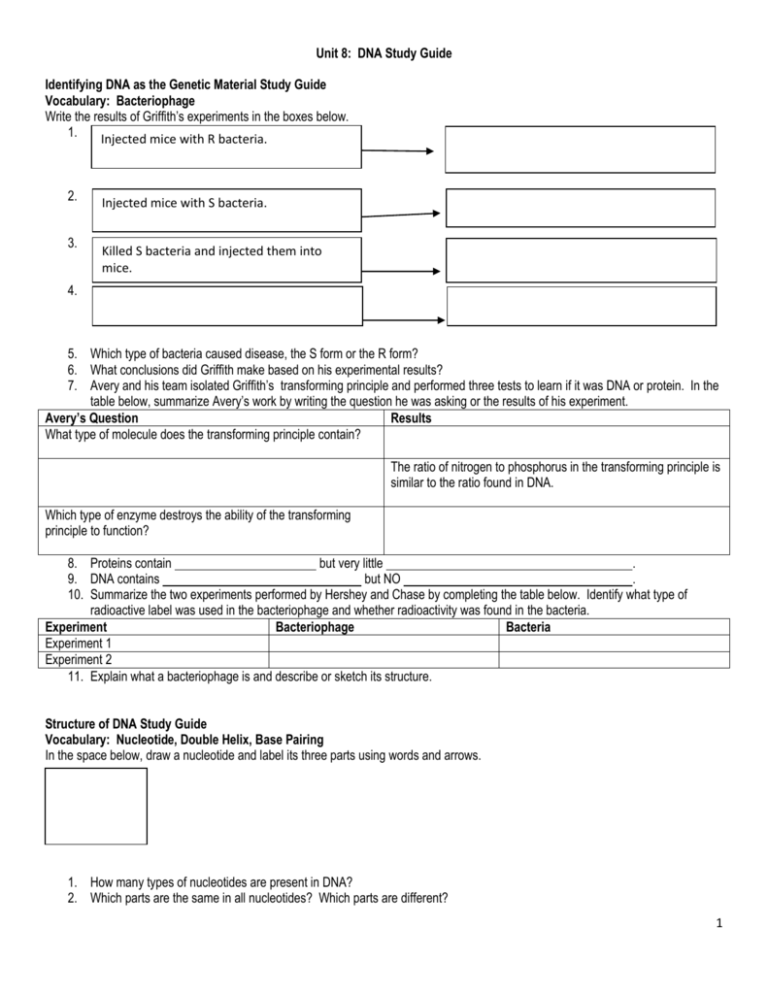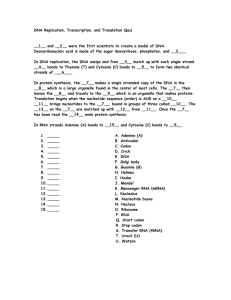Identifying DNA as the Genetic Material Study Guide
advertisement

Unit 8: DNA Study Guide Identifying DNA as the Genetic Material Study Guide Vocabulary: Bacteriophage Write the results of Griffith’s experiments in the boxes below. 1. Injected mice with R bacteria. 2. 3. Injected mice with S bacteria. Killed S bacteria and injected them into mice. 4. 5. Which type of bacteria caused disease, the S form or the R form? 6. What conclusions did Griffith make based on his experimental results? 7. Avery and his team isolated Griffith’s transforming principle and performed three tests to learn if it was DNA or protein. In the table below, summarize Avery’s work by writing the question he was asking or the results of his experiment. Avery’s Question Results What type of molecule does the transforming principle contain? The ratio of nitrogen to phosphorus in the transforming principle is similar to the ratio found in DNA. Which type of enzyme destroys the ability of the transforming principle to function? 8. Proteins contain but very little . 9. DNA contains but NO . 10. Summarize the two experiments performed by Hershey and Chase by completing the table below. Identify what type of radioactive label was used in the bacteriophage and whether radioactivity was found in the bacteria. Experiment Bacteriophage Bacteria Experiment 1 Experiment 2 11. Explain what a bacteriophage is and describe or sketch its structure. Structure of DNA Study Guide Vocabulary: Nucleotide, Double Helix, Base Pairing In the space below, draw a nucleotide and label its three parts using words and arrows. 1. How many types of nucleotides are present in DNA? 2. Which parts are the same in all nucleotides? Which parts are different? 1 3. What did Franklin’s data reveal about the structure of DNA? 4. How did Watson and Crick determine the three-dimensional shape of DNA? 5. How does DNA base pairing result in a molecule that has a uniform width? 6. What nucleotide pairs with T? C? In the space below, draw a DNA double helix. Label the sugar-phosphate backbone, the nitrogen-containing bases, and the-hydrogen bonds. 7. Explain how the DNA double helix is similar to a spiral staircase. 8. How do the base pairing rules relate to Chargaff’s rule? DNA Replication Study Guide Vocabulary: Replication, DNA polymerase. 1. What is DNA replication? 2. Where does DNA replication take place in a eukaryotic cell? 3. When is DNA replicated during the cell cycle? 4. Why does DNA replication need to occur? 5. If one strand of DNA had the sequence TAGGTAC, what would be the sequence of the complementary DNA strand? 6. What roles do proteins play in DNA replication? 7. What must be broken for the DNA strand to separate? Use words and diagrams to summarize the steps of replication, in order, in the boxes below. 8. 9. 10. 11.DNA polymerase has a function that enables it to detect errors and correct them. 12. Write a short analogy to explain what replication is. Transcription Study Guide Vocabulary: Central dogma, RNA, Transcription, RNA polymerase, mRNA, rRNA, tRNA Label each of the processes represented by the arrows in the diagram below. Write where each of these processes takes place in eukaryotic cells. 1. DNA RNA Proteins 2. 3. Fill in the Table below to contrast DNA and RNA DNA RNA 4. Contains the sugar deoxyribose. 5. Has the bases A, C, G, and U 6. Typically double stranded. 7. What enzyme helps a cell make a strand of RNA? 8. Summarize the 3 key steps of transcription. 9. Write the basic function of each type of RNA. a. mRNA: 2 b. rRNA: c. tRNA: 10. List two similarities between transcription and replication. 11. List two differences between transcription and replication. Translation Study Guide Vocabulary: Translation, Codon, Stop Codon, Start Codon, Anticodon 1. What is translation? 2. What is a codon? 3. What is a reading frame? Use your codon chart to Complete the table below. Codon Amino Acid or Function 5. AGA 6. UAG 7. Tryptophan (trp) 8. GGA 9. and 10. The 11. The 12. A tRNA molecule is attached to an other end. are the tools that help a cell translate mRNA into a polypeptide. subunit of a ribosome holds onto the mRNA strand. subunit of a ribosome has binding sites for tRNA. at one end and has an at the Mutations Study Guide Vocabulary: Mutation, Point Mutation, Frameshift Mutation, Mutagen 1. List two types of gene mutations. 2. List two types of chromosomal mutations. 3. Which type of mutation affects more genes, a gene mutation or a chromosomal mutation. 4. What leads to gene duplication? 5. What is translocation? Use the following string of nucleotides to give an example of a point mutation and a frame-shift mutation. AGGCGTCCSTGA 6. Point 7. Frame-shift 8. For a mutation to be passed to offspring, in what type of cell must it occur? 9. Can DNA polymerase catch and correct every mutation error? Explain. 10. What is a mutagen? 11. How does UV light damage the DNA strand? Vocabulary Practice: Bacteriophage Central dogma tRNA promoter frameshift mutation nucleotide RNA translation operon mutagen double helix transcription codon exon base pairing rules RNA polymerase stop codon intron replication mRNA start codon mutation DNA polymerase rRNA anticodon point mutation Read the phrase and write the word it describes, then write another phrase that describes the same word in a different way. Phrase 1 Error that throws off the reading frame of an mRNA sequence Explains Chargaff’s rules States that genetic information flows in one direction. Pairs with an mRNA codon during translation. Word Frameshift mutation Phrase 2 Cause by insertion or deletion of nucleotides 1. 2. 3. 3 An intervening sequence The type of RNA that is converted to a protein during translation. A change in an organism’s DNA Monomers that make up nucleic acids. A sequence of mRNA that is expressed after processing. 4. 5. 6. 7. 8. Circle the word that does not belong and explain WHY it does not belong. 1. Mutagen rRNA tRNA Explain: 2. Codon mRNA Replicaiton Explain: 3. Central dogma mutagen mutation Explain: 4. Codon double helix frameshift mutation Explain: 5. Bacteriophage RNA polymerase transcription Explain: 4







